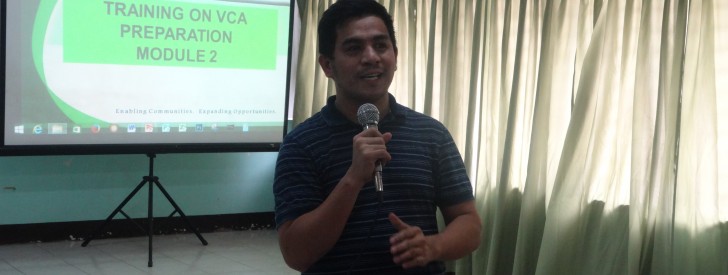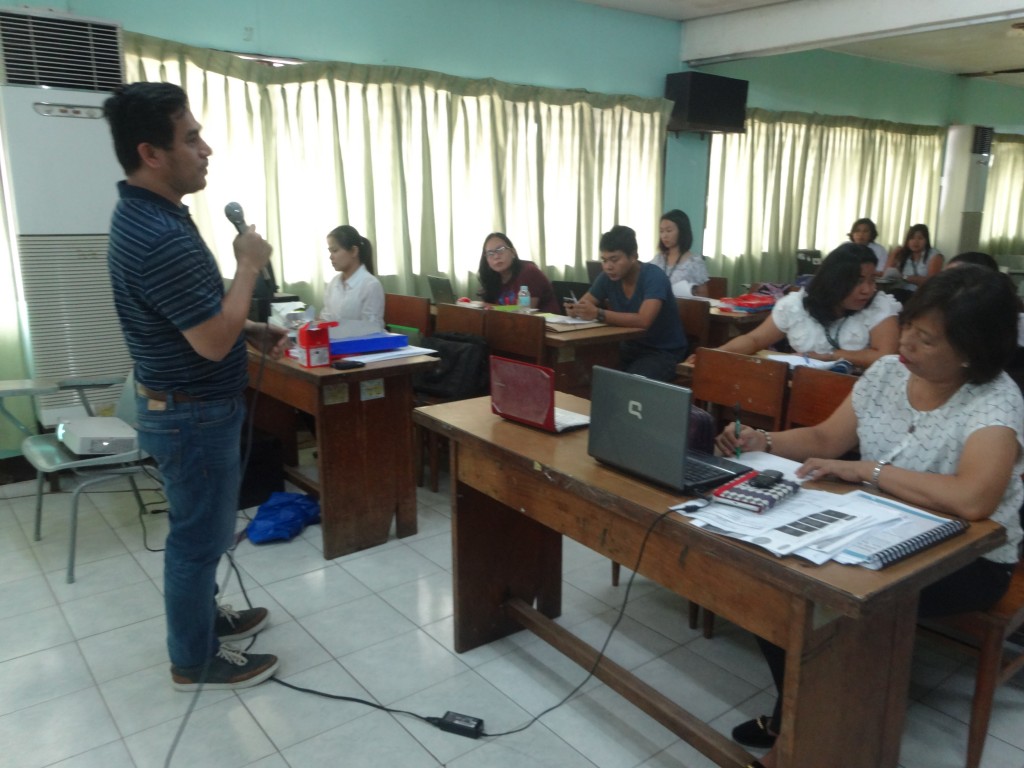 PRDP PSO South Luzon I-PLAN Component Head Rey B. Lara provides the participants with an overview of the Training on VCA Preparation Module 2 (Interfirm Relationships, Constraints and Opportunities and Ecnomic Analysis). (Photo by Annielyn L. Baleza, DA-PRDP RPCO V InfoACE Unit)
PRDP PSO South Luzon I-PLAN Component Head Rey B. Lara provides the participants with an overview of the Training on VCA Preparation Module 2 (Interfirm Relationships, Constraints and Opportunities and Ecnomic Analysis). (Photo by Annielyn L. Baleza, DA-PRDP RPCO V InfoACE Unit) PRDP I-PLAN aligns with new Agriculture chief’s policy agenda using VCA
Value chain analysis, a science-based tool being used by the Philippine Rural Development Project (PRDP) that provides a snapshot of the industry from “seed to shelf” is aligned with the context of the new administration’s policy agenda. This is according to Rey B. Lara, Investments in Agriculture and Fisheries Modernization Plan (AFMP) Planning at the Local and National Levels (I-PLAN) Component Head of PRDP South Luzon.
In an interview during the Value Chain Analysis (VCA) Training Module 2 held on July 20-22, 2016 at the RIARS Training Center in Brgy. San Agustin, Pili, Camarines Sur, Lara noted that the Project’s I-PLAN is parallel with the direction of the Department of Agriculture (DA) to go back to the basic of producing food and addressing poverty.
During new DA Secretary Emmanuel F. Piñol’s first official visit in Bicol on July 12, 2016 to consult with Bicol local chief executives and farmer leaders, he announced that to achieve food sufficiency, the DA will focus its programs in two areas which are staple food commodities to ensure food security and high value crops to generate jobs and foreign earnings.
“The secretary is really determined in supporting our high value crops other than rice. So, these commodities are aligned to the agenda and priorities of the new administration and they could be a vehicle for poverty reduction, achieving food sufficiency and affordability, and attaining economic growth,” Lara said.
Initiated by PRDP I-PLAN-Bicol headed by Aloha Gigi I. Bañaria, Module 2 of the VCA Training focused on the assessment of interfirm relationships, conduct of economic analysis, and identification of constraints and opportunities as well as ugrading strategies. The training was attended by planners from the mainland provinces of Bicol as well as representatives from DA Bicol’s banner programs including High Value Crops Development Program, Rice Program, Organic Agriculture and Livestock Program. Also present was Florizel M. Lim, Municipal Agriculture Officer (MAO) of San Fernando, Masbate, one of Bicol’s pre-identified Global Environment Facility (GEF) sites, along with his staff.
Lara underscored that VCA is a tool to determine who is gaining the highest and least profit. Ironically, the VCAs show that the farmers who spend more time, resources, and efforts in producing commodities earn less unlike the traders who get the biggest share of the profit.
“This is a good planning tool. The VCA, yung kanyang utility value should be maximized kasi it’s in the VCA that we find the recommendations of the industry, how to make the industry move forward, how to make the industry competitive and how to enjoin the industry players and stakeholders to support every commodity and every segment of the value chain,” he added.
According to Lara, Bicol is advanced in terms of number of VCAs, involvement of partner agencies, and mainstreaming the DA banner programs and local government units. Bicol currently has 16 VCAs, six of which were already approved namely coco geonets for Albay and Camarines Norte, coco sap sugar for Camarines Sur, abaca for Catanduanes, sweet potato for Albay, pineapple for Camarines Norte, and cassava for Camarines Sur. Five other VCAs are for review of the PRDP national office including seaweeds and pili of Sorsogon, mangrove crab of Catanduanes, live goat and coconut shell charcoal of Masbate. Data-gathering is on-going for five more VCAs such as organic rice for Sorsogon, smoked fish or tinapa for Camarines Norte, laing or taro leaves for Albay and dairy cattle for Camarines Sur and cut flower for Naga City.
Results of the VCA are being integrated in the Provincial Commodity Investment Plan, a three-year rolling consensus plan between the DA and the PLGU that serves as basis in selecting eligible interventions or sub-projects within the segments of the value chain for funding under PRDP.
To operationalize the VCA, Lara suggested the convergence of provinces to look into their partner agencies’ commitments for the next planning and budgeting exercise. He also recommended conducting regional investment forum to link farmer-producers to prospective markets. Moreover, he wants to spearhead a clusterwide VCA training for municipalities covered by the GEF sites. (Annielyn L. Baleza, DA-PRDP RPCO V InfoACE Unit)

